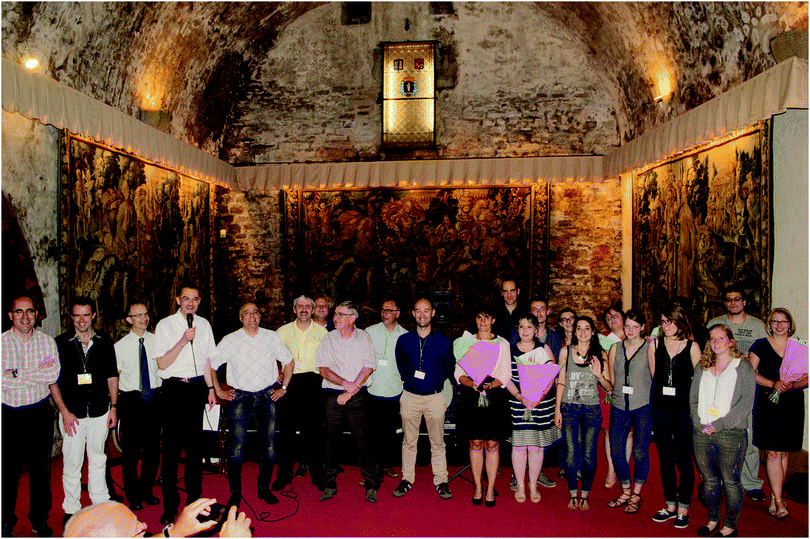Equilibrium solution coordination chemistry
Michel
Meyer
 *,
Claude P.
Gros
*,
Claude P.
Gros
 and
Laurent
Plasseraud
and
Laurent
Plasseraud

Institut de Chimie Moléculaire de l'Université de Bourgogne (ICMUB), UMR 6302, CNRS, Université de Bourgogne – Franche-Comté, 9 avenue Alain Savary, BP 47870, 21078 Dijon Cedex, France. E-mail: michel.meyer@u-bourgogne.fr; Tel: +33 3 80 39 37 16
• Speciation, chemometrics and methodology.
• Solution equilibria and kinetics in relation to coordination chemistry, supramolecular chemistry, drug design, etc.
• Analytical methods and sensors based on metal complexes.
• Solution equilibria and industrial processes (e.g. hydrometallurgy, ion-exchange, catalysis, etc.)
• Nanostructured metal complexes.
• Metal complexes of environmental and biological interest (e.g. proteomics and metabolomics, interactions with metalloenzymes and biomolecules, etc.)
• Metals in health sciences (e.g. transport, homeostasis, toxicity, therapy, diagnosis and imaging, etc.)
In homage to the founding fathers, who established the fundamental concepts of equilibrium solution coordination chemistry a century ago, and to their inspired followers, some of whom became our mentors, this themed issue seeks to highlight the latest advances in the field. With more than 80 contributions from all over the world, this special issue is a showcase of the creativity and vitality of solution chemists with various backgrounds and centers of interest. More than half of the papers are co-authored by scientists who attended the International Symposium on Metal Complexes (ISMEC 2017 – https://ismec2017.sciencesconf.org) held on June 11–15, 2017 in Dijon, France. Since 1974, it has been the sole annual conference devoted to the solution equilibrium chemistry and thermodynamics of complexes. This uninterrupted series of annual meetings, launched by the “Gruppo di Termodinamica dei Complessi” (GTC – http://www.gtc2014.com), began in 1974 in Firenze, which will also host the 45th edition on June 3–7, 2018. In recent years, previous ISMEC conferences were held in Bilbao (2010), Taormina (2011), Lisbon (2012), Burgos (2013), Pavia (2014), Wroclaw (2015), and Barcelona (2016). The historical city of Dijon, a landmark for medieval, renaissance and classical architecture (the picture on the front cover provides a taste of it), but also for gastronomy, fine wines, and the so-called “French art de vivre”, hosted the 44th meeting in 2017 (Fig. 1). Nearly 170 delegates from both academia and industry, including Nobel Laureate Prof. Jean-Pierre Sauvage, represented 20 different countries from 4 continents. The scientific program comprised altogether 5 plenary and 10 keynote lectures, 43 oral communications, and 86 posters. The open access proceedings of the meeting have been published in volume 7 of Acta of the International Symposia on Metal Complexes (ISSN: 2239-2459), available from the GTC web page and the HAL repository of scholarly documents (https://hal.archives-ouvertes.fr/).
This themed issue appears as a timely collective volume, which brings together not only manuscripts from key contributors to the various topics discussed during this conference, but also papers written by renowned colleagues upon invitation, along with a few articles taken from the spontaneous submissions to New J. Chem. that fit within these themes. The full list of articles appearing in this issue can be consulted on the journal home page (www.rsc.org/njc), under the Themed Collections tab. We hope that this selection of focus articles, perspectives, and regular research papers will be useful learning guides for newcomers or refreshers for those already working in the area.
The Guest Editors gratefully acknowledge the Royal Society of Chemistry and the Centre National de la Recherche Scientifique for the publication of this themed issue. Furthermore, we would like to thank the Editor-in-Chief, the Associate Editors, and all the members of the publishing office in Cambridge, with a special mention to Dr Caroline Knapp, for efficient handling of the manuscripts, including the intense reviewing process that guarantees the quality of the accepted papers. Nearly 90 submissions were handled in the usual way with international and independent peer review. We are in debt to the numerous volunteer referees and, of course, to all the invited authors for their contributions.
Enjoy this themed issue!
| This journal is © The Royal Society of Chemistry and the Centre National de la Recherche Scientifique 2018 |

